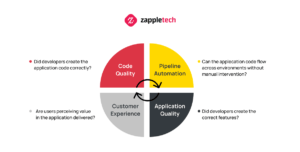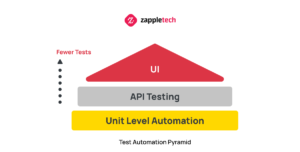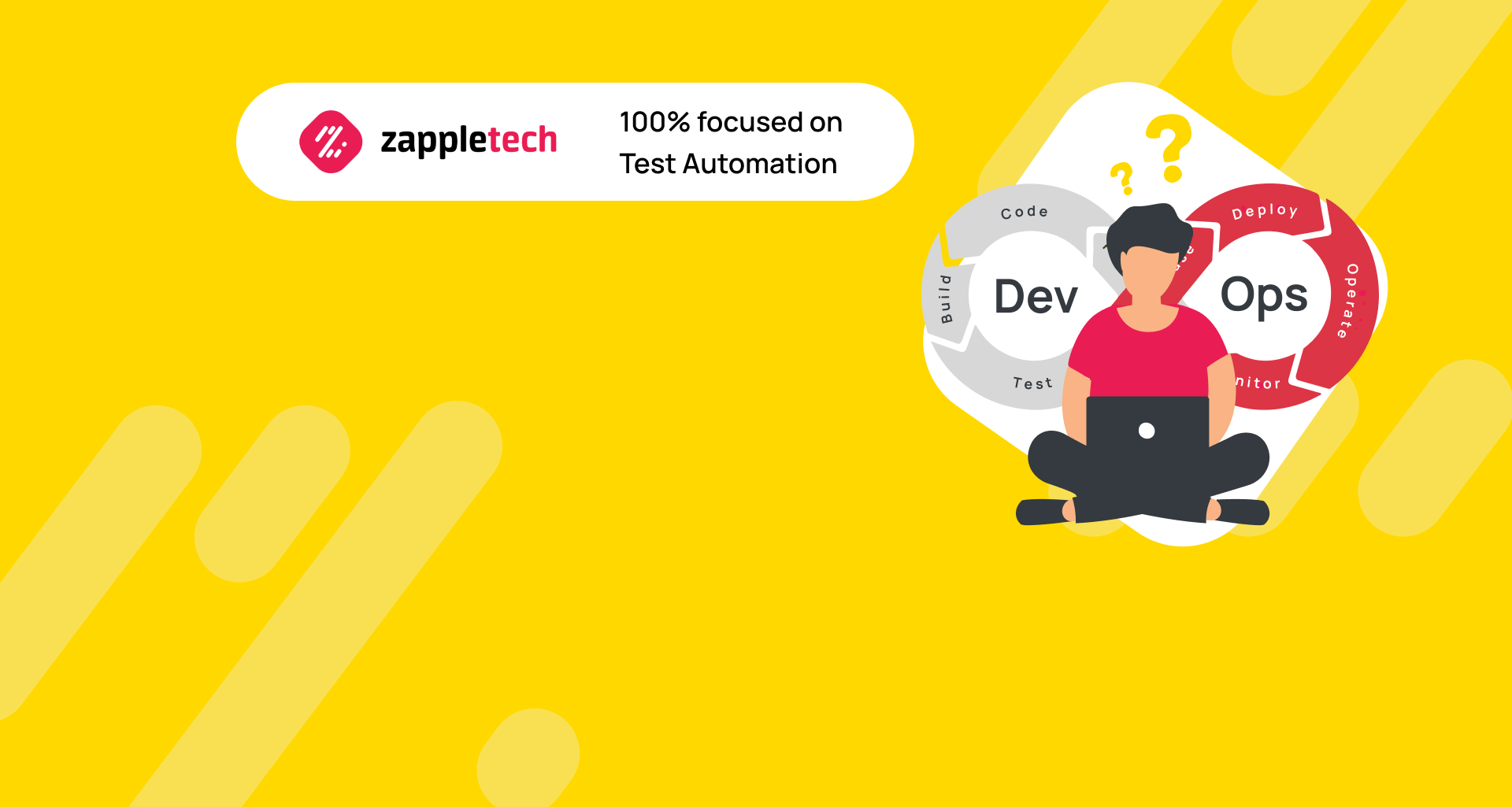Table of Contents
Introduction
What is continuous testing?
The role of Continuous Testing in DevOps
Continuous Testing is done to improve the quality of software in terms of security, functionality, and overall performance. This approach integrates the development, build, and testing phases within a company, allowing for a more streamlined and efficient workflow. Continuous testing in DevOps is particularly valuable as it enables faster feedback loops and quicker identification of issues, which can then be addressed promptly.
When a developer makes a change to the code, code coverage tools automatically check these changes to identify any errors or performance issues that may have been introduced. This immediate feedback helps developers spot and fix problems early in the development cycle, reducing the likelihood of defects making it into production.
The software undergoes rigorous testing in the test environment, where the actual results are compared against the expected outcomes. If discrepancies are found, the software is retested in the Dev environment, repeating the process until the results align and the software achieves stability. This iterative approach ensures that the software meets the desired standards of quality before it is released.
This method saves significant time and resources, as developers can continue making code changes while QA teams test the software concurrently, without the need to wait for the development phase to fully complete. Continuous testing in DevOps thus supports ongoing integration and delivery processes, promoting faster releases and maintaining high software quality throughout the development lifecycle.
Key components of DevOps test automation

Continuous testing is more than just continuous feedback loops. There are a number of different components that make it a reality, each of which relies on a set of processes, technology approaches and continuous testing tools in DevOps. There are four key components that you need to keep in mind when working on your next continuous testing project.
1) Continuous integration
Continuous integration (CI) is a crucial practice in software development, where code changes from multiple contributors are frequently integrated into a shared repository. This approach allows for automatic verification of each integration through automated testing, ensuring that new changes do not break existing functionality. By continuously integrating code, developers can catch and resolve errors quickly, which accelerates the development process and enhances software quality.
In DevOps environments, continuous integration works hand-in-hand with continuous testing in DevOps, where automated tests are run as part of the CI pipeline. This ensures that every change is tested for errors and functionality, supporting a more reliable and efficient workflow. By incorporating continuous testing in DevOps, teams can maintain high-quality code standards, reduce integration issues, and deliver software updates more frequently and reliably. This synergy between continuous integration and continuous testing in DevOps is essential for modern development practices, enabling rapid feedback and swift resolutions to any issues that arise during the integration process.
2) Environment provisioning
Environment provisioning is the process of setting up a virtual or physical environment necessary for testing. This involves creating a dedicated testing environment on a separate system from production, which ensures that tests do not interfere with the live application. Provisioning can include setting up test databases, configuring necessary services, creating a test network, and preparing the user interface environment for testing. This process is critical for effective continuous testing in DevOps, as it helps maintain consistency and reliability across testing phases.
Traditionally, environment provisioning can be time-consuming, often leading to delays in the testing pipeline. However, with modern container-based platforms like Docker, provisioning has become significantly faster, reducing the time from minutes to seconds. By leveraging containers, teams can create lightweight, isolated environments using minimal operating systems tailored for specific testing needs. This streamlined approach not only accelerates environment setup but also supports continuous testing in DevOps by enabling rapid, repeatable, and scalable testing environments, crucial for maintaining high software quality throughout the development lifecycle.
3) Automation
Automation plays a critical role in the successful implementation of continuous testing in DevOps environments. One of the key components of a continuous testing approach is the automation of various testing types, including API integration testing and UI testing. By incorporating continuous testing in DevOps, teams can streamline the testing process, allowing for faster feedback loops and more reliable code delivery.
With a robust test automation plan, you’ll be able to create and execute tests with ease, ensuring that new changes are consistently validated against existing functionality. This approach not only reduces manual effort but also enhances the accuracy and efficiency of testing cycles. Having a consistent testing methodology and leveraging automation tools will make it easy for you to create tests quickly, maintain them efficiently, and integrate them seamlessly into your CI/CD pipeline.
If you have a test automation plan in place, you will be able to easily create test cases and test suites that are reusable, scalable, and adaptable to changing project needs. Continuous testing in DevOps emphasizes the importance of early and continuous feedback, allowing teams to identify issues sooner in the development process and address them before they become critical. By automating these testing processes, teams can maintain high-quality standards and keep up with the rapid pace of development, ultimately leading to more stable and reliable software releases.
4) Collaboration
Collaboration plays a crucial role in the success of continuous testing, especially within DevOps environments where the synergy between development and operations is key to delivering high-quality software at speed. Continuous testing in DevOps relies heavily on close collaboration among developers, testers, and other stakeholders, which ensures that testing is integrated into every stage of the software development lifecycle.
A small, focused group is often the best way to start. This team works collaboratively on a single change or feature, dedicating their efforts uninterrupted until it’s ready for production. By adopting a pair or trio format, testers work closely together to first write the tests and then develop the code necessary to pass those tests. This test-first approach not only promotes high code quality but also helps identify issues early, reducing the risk of defects making it into production.
The goal is to create tests that are both easy to read and understand, fostering greater collaboration and transparency across the team. Once the initial tests are complete and the corresponding code is written, the team continues to refine and refactor the code to improve its readability and performance. This iterative process embodies the essence of continuous testing in DevOps, where collaboration and communication are not just encouraged but are foundational to achieving a seamless, automated testing pipeline.
How to implement continuous testing?
To implement continuous testing effectively, it’s crucial to integrate testing into every phase of the development lifecycle, aligning it closely with your DevOps practices. This approach, known as “continuous testing in DevOps,” emphasizes the need for constant feedback loops, enabling teams to identify and resolve issues early and often.
Start by embedding quality at the code level with automated unit tests that run every time the code is changed. Incorporating automated tests for code, APIs, and UI helps ensure that changes do not introduce new bugs, maintaining the integrity of the application. Additionally, consider implementing a test-driven development (TDD) approach, where tests are written before the actual code, guiding the development process.
Break down the continuous testing process into smaller, manageable parts, such as unit testing, integration testing, performance testing, and security testing. Each of these stages should include automated checks that run seamlessly within your CI/CD pipeline. By embedding quality checkpoints throughout the application pipeline, you ensure that potential issues are caught as early as possible, reducing the risk of defects reaching production.
Furthermore, it’s essential to use modern testing tools that support “continuous testing in DevOps,” such as Selenium, JUnit, or Cypress, which offer capabilities for automated and scalable testing across various environments. Regularly updating and maintaining your test suites is also crucial to keep up with changes in your application and ensure that tests remain relevant and effective.
By systematically embedding quality checks and leveraging continuous testing in DevOps, you can enhance the overall reliability and efficiency of your software delivery process, ultimately leading to a higher-quality product and faster release cycles.
Virtualized Environments
Continuous testing in DevOps plays a crucial role in ensuring that code changes are continuously validated throughout the software development lifecycle. Continuous testing implies running tests frequently, often many times within a few hours or days. However, executing these tests multiple times a day can introduce challenges, particularly when it comes to resource allocation and environment management. This is where virtualized environments become essential.
By leveraging virtualized environments, you can efficiently run your tests in a controlled, isolated setting that mimics your production environment. This approach supports continuous testing in DevOps by providing a scalable testing environment, ensuring that tests do not interfere with each other and can run concurrently. However, this setup can also create a bottleneck if there aren’t enough virtualized environments available. Therefore, it’s crucial to maintain an adequate number of environments that are readily accessible to avoid delays and ensure continuous integration and delivery processes are smooth.
Use automation tools to run tests automatically as part of the CI/CD pipeline. Focus on automating repetitive and regression tests to free up resources for more complex exploratory testing, and ensure consistent results.Mikhail BodnarchukCDO, ZappleTech Inc.
Virtual environments act as containers that isolate their resources and dependencies from the host machine, allowing you to run applications and tests independently. This isolation is particularly beneficial in continuous testing in DevOps, as it helps ensure that tests are executed in a consistent environment, which is critical for reliable results. Moreover, virtual environments enable you to quickly spin up or modify environments as needed, providing flexibility when changes are required or when scaling up test coverage.
When changes need to be validated, tests can be run in these virtual environments to ensure that only the relevant code is tested. If adjustments are necessary, you can update the virtual environment and then deploy the refined version into the production environment with confidence. This ability to manage and modify environments on the fly not only supports continuous testing in DevOps but also enhances the overall efficiency of the development and deployment pipeline.
Test Data Management
Continuous testing requires businesses to have a data management strategy, and a data set to work with. The data set should be diverse enough in order to test a variety of software products. If a company has the right data management strategy, it can help keep test data organized, which will make it easier to produce test data and then sort it before it is used in testing.
This will help ensure that the test data is relevant because it represents the actual software that the business is using. The data sets should include different data and be based on different versions of software and should include different devices and different people who are likely to use the software. This will help you to test how the software will work with a variety of people and devices.
The business needs a platform that can create test data and support the diverse needs of the software products. There are a few different ways to create test data: using a script, small pieces of data, or combining test data. Data management should be run by a data scientist. This specialist will identify test data needs and create the best strategy for creating and collecting the data.
Test Automation
Continuous testing in DevOps has become a crucial aspect of modern software development, ensuring that feedback is immediate and that software quality remains high throughout the development cycle. To make continuous testing effective, you need a comprehensive test automation solution that goes beyond executing test cases. Test automation should encompass the entire testing process, including data collection, test management, and the analysis of test results to ensure that every aspect of the software is functioning as expected.
Setting up reliable test automation is essential for enabling continuous testing in DevOps. This involves selecting the right tools and frameworks, such as Selenium for web application testing, which is excellent for identifying syntax-based errors. However, the choice of tools should align with the specific needs of your project, whether it’s testing APIs, mobile applications, or complex workflows. Continuous testing relies on a well-integrated test automation setup that supports continuous integration and delivery pipelines, allowing teams to detect issues early and reduce the time to market.
Moreover, it is important to incorporate best practices in test automation, such as maintaining test scripts, using version control, and ensuring that tests are scalable and maintainable. These practices help in keeping the test automation framework robust and adaptable to changes in the application, thereby supporting the continuous testing process effectively.
Pipeline Orchestration
In order to benefit from the value of Continuous Testing, in order to provide a continuous feedback loop, you need to have an orchestrated pipeline that can handle the continuous feedback loop. This orchestration is a set of tasks that will get your application integrated with Continuous Testing and make it work as intended.
To establish the transparency of a pipeline, you need to make sure that the workflow tool being used is fully integrated with your build and deployment processes. Here, it can process all the necessary information needed to make continuous testing successful.
For example, if you’re using Jenkins, you’ll need to run a Jenkins job that will install the continuous testing tool (with the appropriate plugins for your build and deployment process) on your behalf.
API Testing
To properly adopt Continuous Testing, organizations must recognize the importance of the testing pyramid and test as much as possible at the unit and API levels.

The testing pyramid is a model for how and where to focus your testing efforts. It states that you should test your unit level first, then your API level, and finally your UI level. However, to make sure that the testing pyramid is becoming the best practice for your organization, you can begin by focusing on API testing.
By adopting continuous testing, you’ll be able to test your APIs to the fullest extent and minimize the reliance on UI testing.
Conclusion
We hope you enjoyed our blog post and found the insights valuable. As the landscape of software development evolves, embracing practices like continuous testing in DevOps becomes increasingly essential. Continuous testing in DevOps facilitates a seamless integration of testing into the development process, allowing your team to catch defects early and often, which in turn reduces the cost and effort required to fix them later in the cycle.
This approach not only boosts overall software quality but also enhances collaboration between development, testing, and operations teams, fostering a culture of shared responsibility for quality. Continuous testing in DevOps supports a proactive approach to quality assurance, helping your team deliver software that meets customer expectations in terms of both functionality and performance.
By maintaining a continuous feedback loop, teams can quickly respond to changes, adapt to new requirements, and release updates more frequently without compromising on quality. The benefits of continuous testing in DevOps are clear: faster time to market, reduced risks, and a more reliable end product. If you have any questions or concerns about implementing continuous testing in your DevOps pipeline, please don’t hesitate to reach out to us. We are here to support you on your journey to achieving continuous delivery excellence!






